Answered step by step
Verified Expert Solution
Question
1 Approved Answer
write the report on: 1:) organizational overview 2:) Identification of interpersonal issues. The Radar Project Case Overview This case follows a project team as they

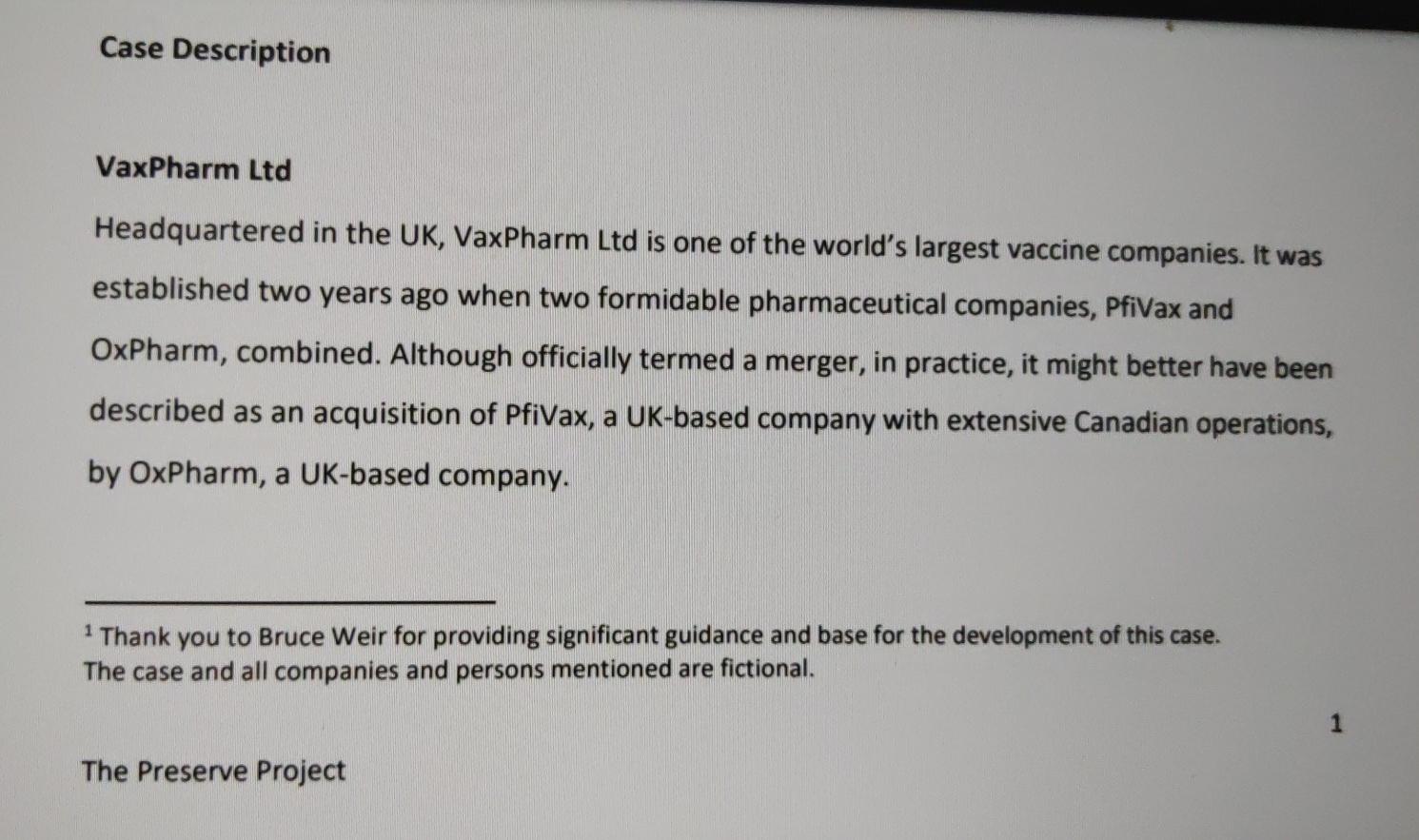
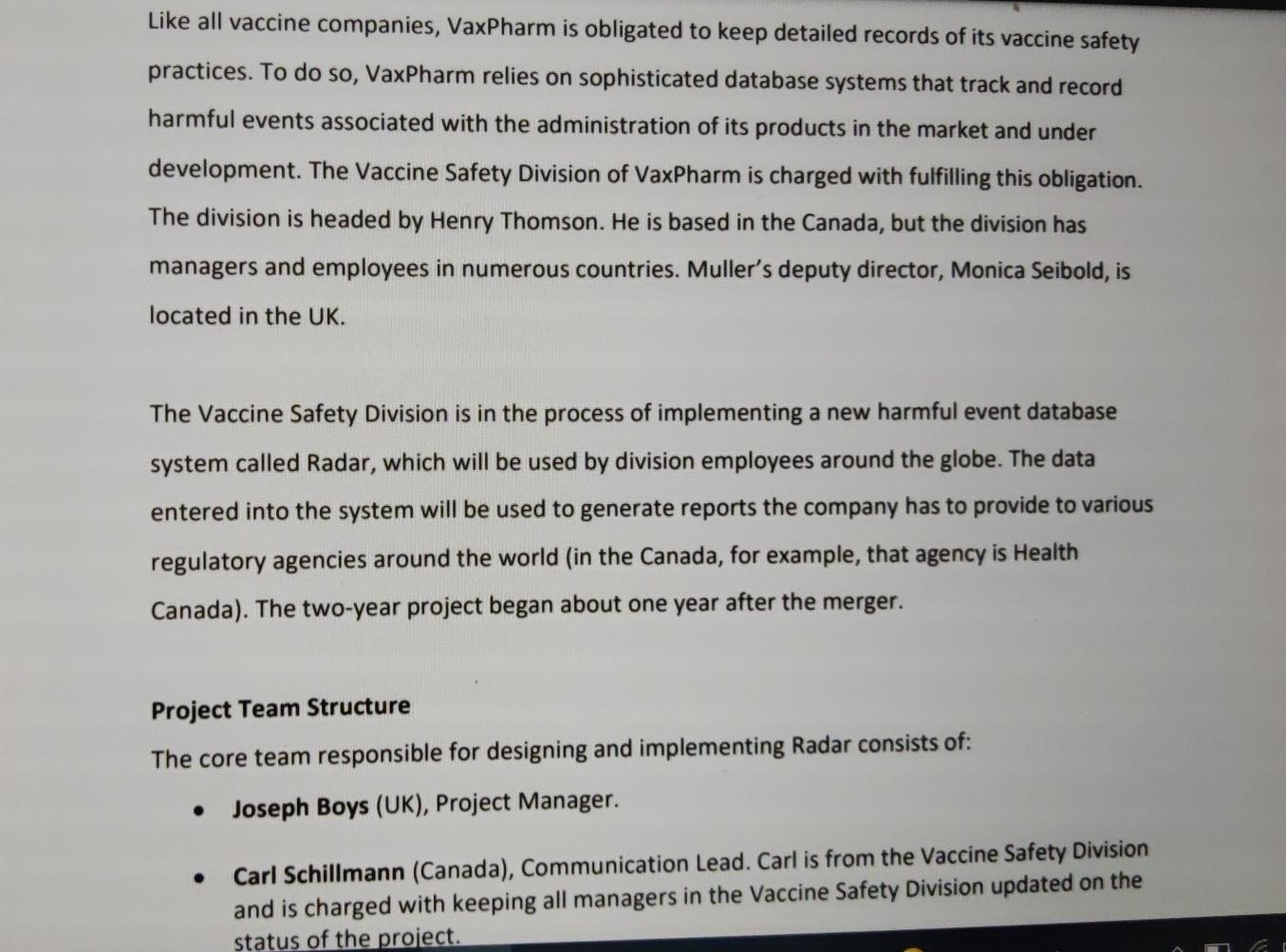
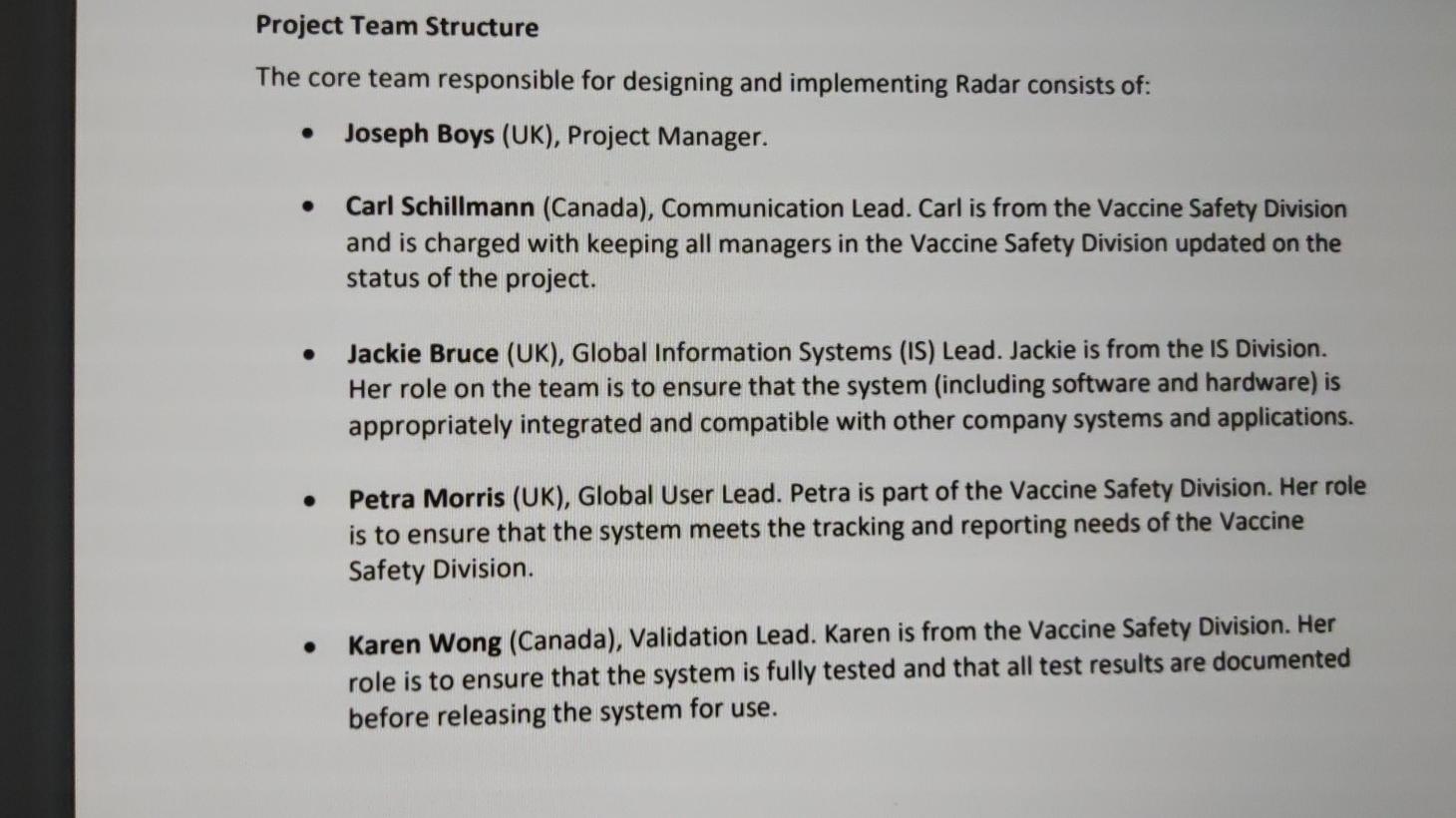
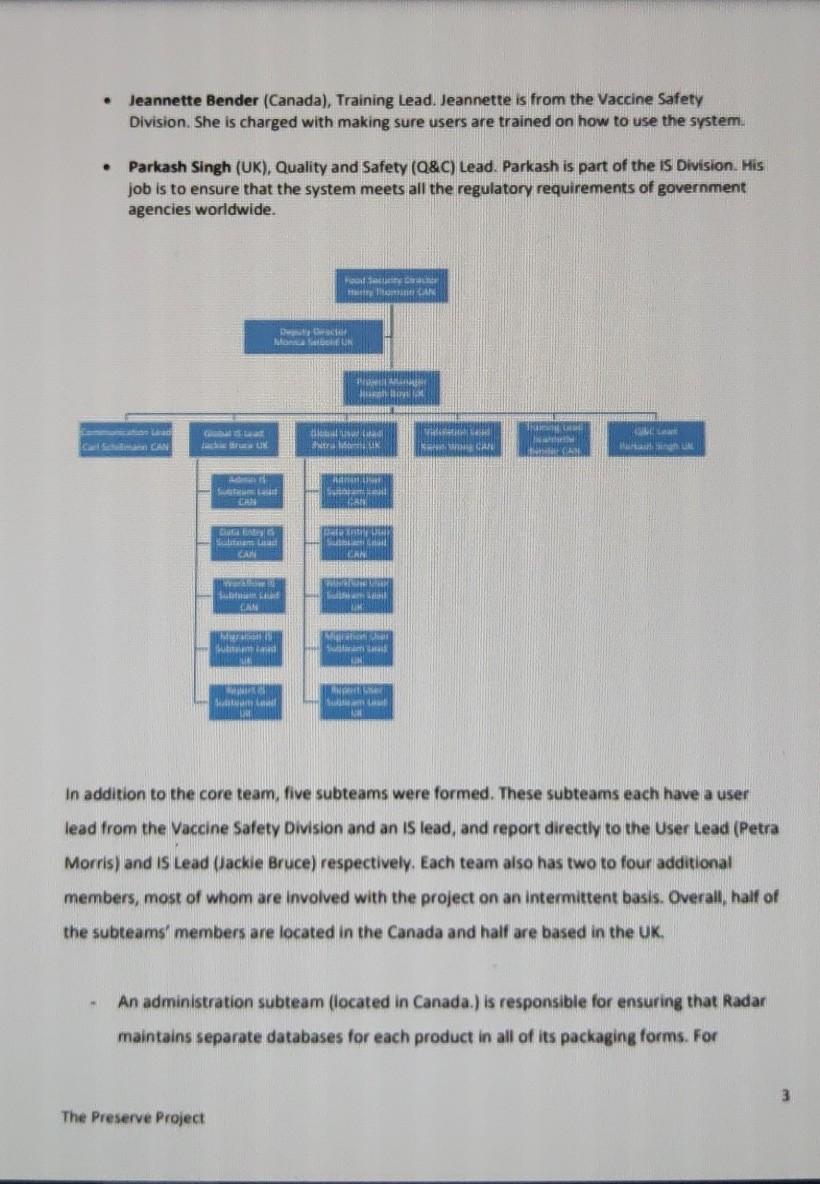

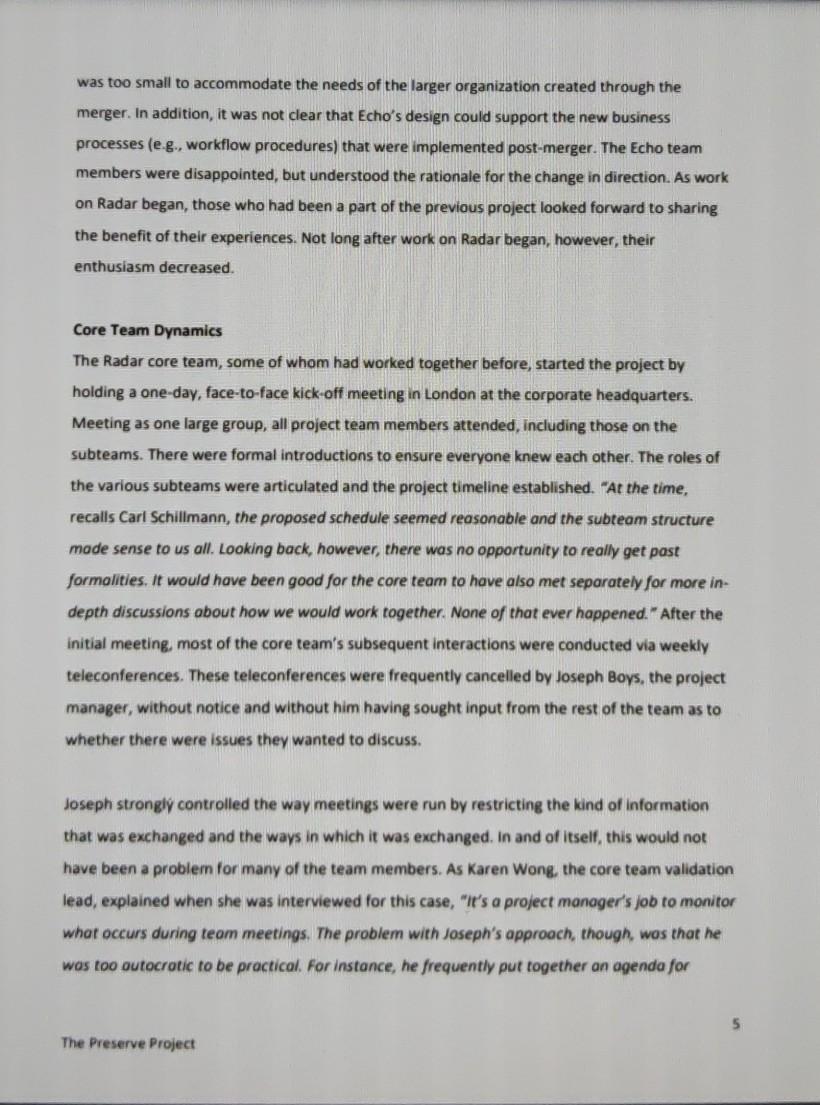
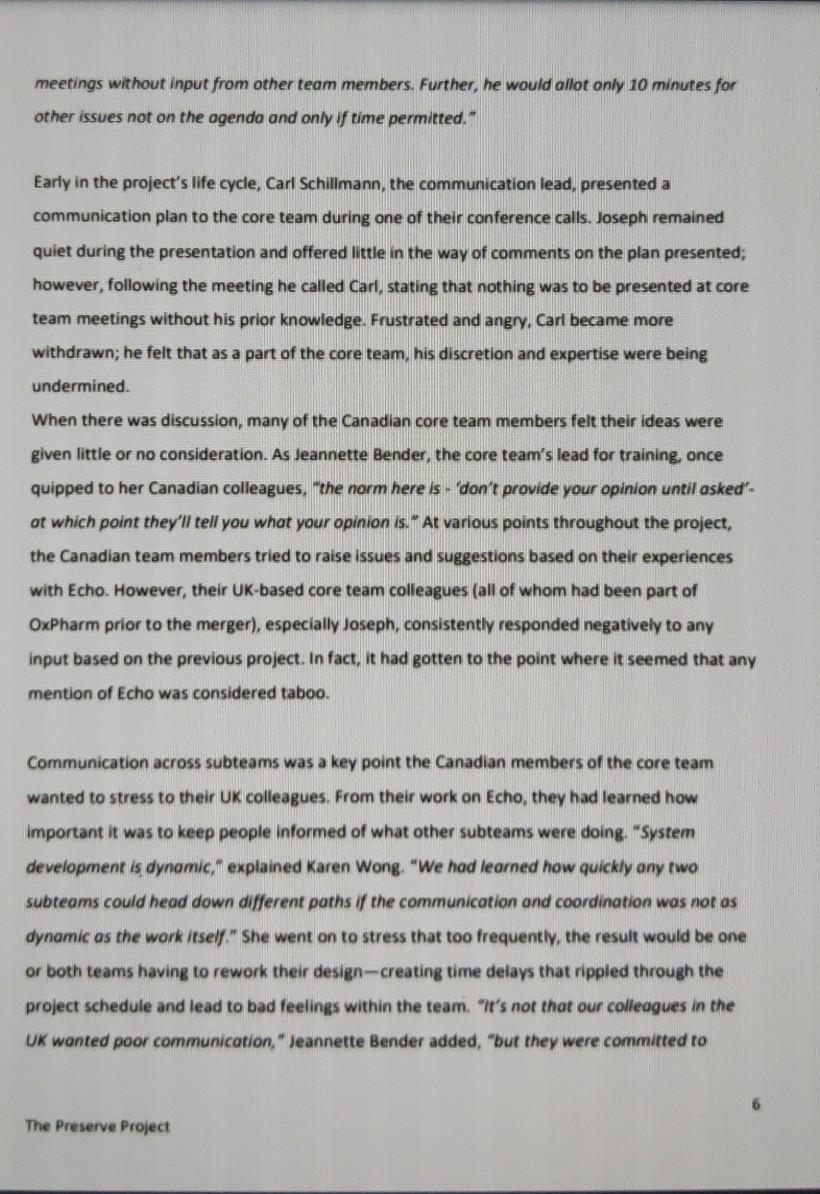
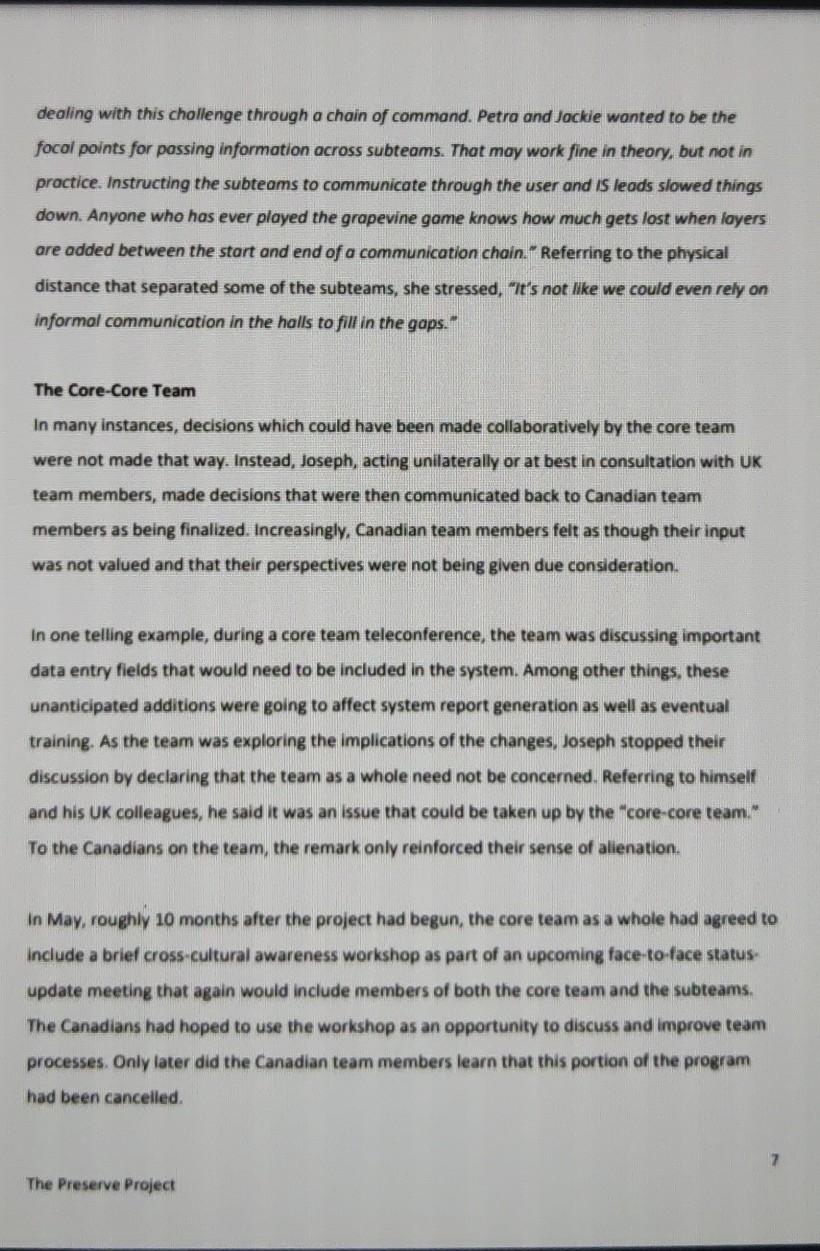
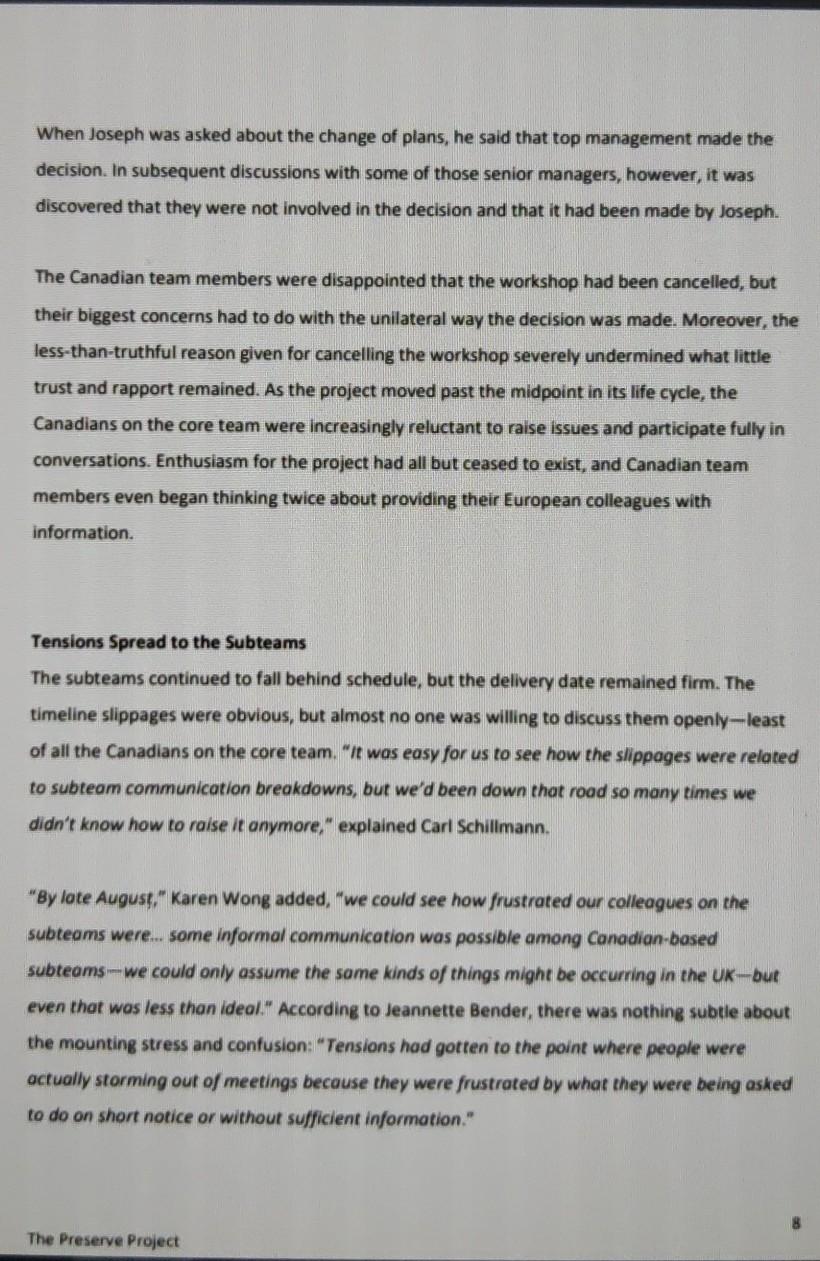

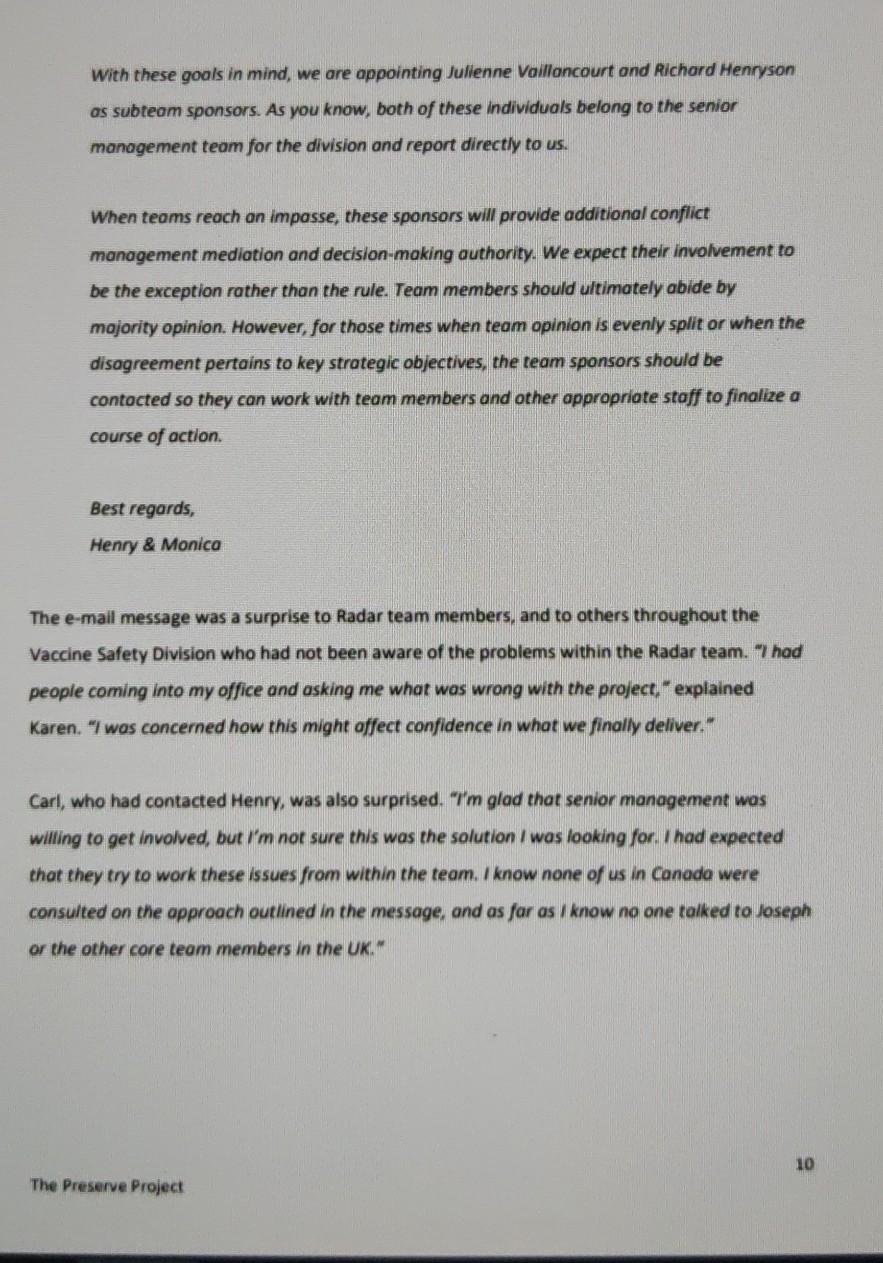
write the report on: 1:) organizational overview 2:) Identification of interpersonal issues.
The Radar Project Case Overview This case follows a project team as they work to implement a vaccine safety database tracking system within a major international pharmaceutical company. The company was formed through the merger of two organizations. Team members are located in Canada and in the UK, and conduct much of their work virtually. In spite of their technical skills and abilities, the team struggles to collaborate; after more than a year of work, key conflicts remain unresolved- many of which are not apparent to all team members. The case concludes with senior management appointing process advisors and implementing a conflict escalation process. Whether these interventions are effective or even appropriate remains an open question for students to explore. Review this case as if you are a consultant hired by the company to improve the team's dynamics. As you read, keep in mind that the case is written primarily from the perspective of the Canadians on the team. Look for the merits in their points of view, but consider how the same facts might be interpreted differently. Case Description VaxPharm Ltd Headquartered in the UK, VaxPharm Ltd is one of the world's largest vaccine companies. It was established two years ago when two formidable pharmaceutical companies, PfiVax and OxPharm, combined. Although officially termed a merger, in practice, it might better have been described as an acquisition of Pfivax, a UK-based company with extensive Canadian operations, by OxPharm, a UK-based company. 1 Thank you to Bruce Weir for providing significant guidance and base for the development of this case. The case and all companies and persons mentioned are fictional. The Preserve Project Like all vaccine companies, VaxPharm is obligated to keep detailed records of its vaccine safety practices. To do so, VaxPharm relies on sophisticated database systems that track and record harmful events associated with the administration of its products in the market and under development. The Vaccine Safety Division of VaxPharm is charged with fulfilling this obligation. The division is headed by Henry Thomson. He is based in the Canada, but the division has managers and employees in numerous countries. Muller's deputy director, Monica Seibold, is located in the UK. The Vaccine Safety Division is in the process of implementing a new harmful event database system called Radar, which will be used by division employees around the globe. The data entered into the system will be used to generate reports the company has to provide to various regulatory agencies around the world (in the Canada, for example, that agency is Health Canada). The two-year project began about one year after the merger. Project Team Structure The core team responsible for designing and implementing Radar consists of: Joseph Boys (UK), Project Manager. . Carl Schillmann (Canada), Communication Lead. Carl is from the Vaccine Safety Division and is charged with keeping all managers in the Vaccine Safety Division updated on the status of the project. Project Team Structure The core team responsible for designing and implementing Radar consists of: Joseph Boys (UK), Project Manager. Carl Schillmann (Canada), Communication Lead. Carl is from the Vaccine Safety Division and is charged with keeping all managers in the Vaccine Safety Division updated on the status of the project. Jackie Bruce (UK), Global Information Systems (IS) Lead. Jackie is from the IS Division. Her role on the team is to ensure that the system (including software and hardware) is appropriately integrated and compatible with other company systems and applications. Petra Morris (UK), Global User Lead. Petra is part of the Vaccine Safety Division. Her role is to ensure that the system meets the tracking and reporting needs of the Vaccine Safety Division. Karen Wong (Canada), Validation Lead. Karen is from the Vaccine Safety Division. Her role is to ensure that the system is fully tested and that all test results are documented before releasing the system for use. Jeannette Bender (Canada), Training Lead. Jeannette is from the Vaccine Safety Division. She is charged with making sure users are trained on how to use the system. Parkash Singh (UK), Quality and Safety (Q&C) Lead. Parkash is part of the Is Division. His job is to ensure that the system meets all the regulatory requirements of government agencies worldwide. Hallo IAN Mo PALAIN wa hu WHA CAN AL UN LA CA S tant KAN CAN FRONTRI La LIH LAM LIN AN In addition to the core team, five subteams were formed. These subteams each have a user lead from the Vaccine Safety Division and an IS lead, and report directly to the User Lead (Petra Morris) and is Lead (Jackie Bruce) respectively. Each team also has two to four additional members, most of whom are involved with the project on an intermittent basis. Overall, half of the subteams' members are located in the Canada and half are based in the UK. An administration subteam (located in Canada.) is responsible for ensuring that Radar maintains separate databases for each product in all of its packaging forms. For The Preserve Project example, if a particular vaccine was sold in 100 milliliter vials and also in pre-filled single use syringes, Radar must separately track any harmful events for both the vials and syringes A data entry subteam (located in Canada) is charged with identifying all of the fields that would appear on the system's screens. A workflow subteam (members evenly divided between Canada and the UK) is responsible for determining the ways in which the system automatically passes work from one user to the next. For example, a case entered into the system would typically first be handled by a data entry clerk before being transferred to a vaccine safety evaluation expert and finally to a reporting officer who would submit the case to regulatory authorities. A migration subteam (located in the UK) is responsible for mapping all the data from the legacy (existing) systems to Radar. A report subteam (located in the UK) is charged with designing the reports that will be generated from Radar. While each of these subteams has a different focus, they are interdependent. For instance, if the data entry subteam failed to include a particular data field, the migration subteam would not be able to move related legacy data into the new system. Most of the Canadian core and subteam members were previously employees of Privax. At the project's start, they were looking forward to working on this initiative. Before the merger, several of them, including all of those on the core team, played key roles in efforts to develop a similar system called Echo. The work had been intense and time-consuming, but the team members were stimulated by that project. They put in long but collaborative hours and were nearly finished when the merger occurred and implementation of Echo was put on hold. Several months later, the newly merged organization decided to scrap Echo in favour of Radar. There were two main reasons. First, having been designed before the merger, Echo's capacity The Preserve Project was too small to accommodate the needs of the larger organization created through the merger. In addition, it was not clear that Echo's design could support the new business processes (eg, workflow procedures) that were implemented post-merger. The Echo team members were disappointed, but understood the rationale for the change in direction. As work on Radar began, those who had been a part of the previous project looked forward to sharing the benefit of their experiences. Not long after work on Radar began, however, their enthusiasm decreased. Core Team Dynamics The Radar core team, some of whom had worked together before, started the project by holding a one-day, face-to-face kick-off meeting in London at the corporate headquarters. Meeting as one large group, all project team members attended, including those on the subteams. There were formal introductions to ensure everyone knew each other. The roles of the various subteams were articulated and the project timeline established. "At the time, recalls Carl Schillmann, the proposed schedule seemed reasonable and the subteam structure made sense to us all. Looking back, however, there was no opportunity to really get past formalities. It would have been good for the core team to have also met separately for more in- depth discussions about how we would work together. None of that ever happened. After the initial meeting, most of the core team's subsequent interactions were conducted via weekly teleconferences. These teleconferences were frequently cancelled by Joseph Boys, the project manager, without notice and without him having sought input from the rest of the team as to whether there were issues they wanted to discuss. Joseph strongly controlled the way meetings were run by restricting the kind of information that was exchanged and the ways in which it was exchanged. In and of itself, this would not have been a problem for many of the team members. As Karen Wong, the core team validation lead, explained when she was interviewed for this case, "It's a project manager's job to monitor what occurs during team meetings. The problem with Joseph's approach, though, was that he was too outocrotic to be practical. For instance, he frequently put together an agenda for 5 The Preserve Project meetings without input from other team members. Further, he would allot only 10 minutes for other issues not on the agenda and only if time permitted. Early in the project's life cycle, Carl Schillmann, the communication lead, presented a communication plan to the core team during one of their conference calls. Joseph remained quiet during the presentation and offered little in the way of comments on the plan presented; however, following the meeting he called Carl, stating that nothing was to be presented at core team meetings without his prior knowledge. Frustrated and angry, Carl became more withdrawn; he felt that as a part of the core team, his discretion and expertise were being undermined. When there was discussion, many of the Canadian core team members felt their ideas were given little or no consideration. As Jeannette Bender, the core team's lead for training, once quipped to her Canadian colleagues, "the norm here is . 'don't provide your opinion until asked' ot which point they'll tell you what your opinion is.At various points throughout the project, the Canadian team members tried to raise issues and suggestions based on their experiences with Echo. However, their UK-based core team colleagues (all of whom had been part of OxPharm prior to the merger), especially Joseph, consistently responded negatively to any input based on the previous project. In fact, it had gotten to the point where it seemed that any mention of Echo was considered taboo. Communication across subteams was a key point the Canadian members of the core team wanted to stress to their UK colleagues. From their work on Echo, they had learned how Important it was to keep people informed of what other subteams were doing. "System development is dynamic," explained Karen Wong. "We had learned how quickly any two subteams could head down different paths if the communication and coordination was not as dynamic as the work itself." She went on to stress that too frequently, the result would be one or both teams having to rework their design-creating time delays that rippled through the project schedule and lead to bad feelings within the team. It's not that our colleagues in the UK wonted poor communication," Jeannette Bender added, "but they were committed to The Preserve Project dealing with this chollenge through a chain of command. Petra and Jackie wonted to be the focal points for passing information across subteams. That may work fine in theory, but not in practice. Instructing the subteams to communicate through the user and is leads slowed things down. Anyone who has ever played the grapevine game knows how much gets lost when layers are added between the start and end of a communication chain." Referring to the physical distance that separated some of the subteams, she stressed, "It's not like we could even rely on informal communication in the halls to fill in the gaps. The Core-Core Team In many instances, decisions which could have been made collaboratively by the core team were not made that way. Instead, Joseph, acting unilaterally or at best in consultation with UK team members, made decisions that were then communicated back to Canadian team members as being finalized. Increasingly, Canadian team members felt as though their input was not valued and that their perspectives were not being given due consideration. In one telling example, during a core team teleconference, the team was discussing important data entry fields that would need to be included in the system. Among other things, these unanticipated additions were going to affect system report generation as well as eventual training. As the team was exploring the implications of the changes, Joseph stopped their discussion by declaring that the team as a whole need not be concerned. Referring to himself and his UK colleagues, he said it was an issue that could be taken up by the "core-core team. To the Canadians on the team, the remark only reinforced their sense of alienation. in May, roughly 10 months after the project had begun, the core team as a whole had agreed to Include a brief cross-cultural awareness workshop as part of an upcoming face-to-face status update meeting that again would include members of both the core team and the subteams, The Canadians had hoped to use the workshop as an opportunity to discuss and improve team processes. Only later did the Canadian team members learn that this portion of the program had been cancelled. 7 The Preserve Project When Joseph was asked about the change of plans, he said that top management made the decision. In subsequent discussions with some of those senior managers, however, it was discovered that they were not involved in the decision and that it had been made by Joseph. The Canadian team members were disappointed that the workshop had been cancelled, but their biggest concerns had to do with the unilateral way the decision was made. Moreover, the less-than-truthful reason given for cancelling the workshop severely undermined what little trust and rapport remained. As the project moved past the midpoint in its life cycle, the Canadians on the core team were increasingly reluctant to raise issues and participate fully in conversations. Enthusiasm for the project had all but ceased to exist, and Canadian team members even began thinking twice about providing their European colleagues with information. Tensions Spread to the Subteams The subteams continued to fall behind schedule, but the delivery date remained firm. The timeline slippages were obvious, but almost no one was willing to discuss them openly-least of all the Canadians on the core team. "it was easy for us to see how the slippages were related to subteam communication breakdowns, but we'd been down that road so many times we didn't know how to raise it anymore," explained Carl Schillmann. "By lote August," Karen Wong added, "we could see how frustrated our colleagues on the subteams were... some informal communication was possible among Conadian-bosed subteams--we could only assume the same kinds of things might be occurring in the UK-but even that was less than ideal." According to Jeannette Bender, there was nothing subtle about the mounting stress and confusion: "Tensions had gotten to the point where people were actually storming out of meetings because they were frustrated by what they were being asked to do on short notice or without sufficient information." The Preserve Project In September, the Canadian core team members felt they needed to escalate their concerns. After consulting with Karen and Jeannette, Carl approached Henry Thomson, the head of the Vaccine Safety Division. According to Carl, Henry, who was also based in Canada, took his concerns seriously and promised to act. "I assumed," said Carl, "that meant Henry would work through Joseph, perhaps coaching and counseling him on how to open up dialogue and communication within the core team and throughout the project overoll. Instead, Henry chose another approach. He sent an e-mail message to the entire division, not Just those working on the Radar project. The message was sent under his name and that of his deputy director, Monica Seibold, who was located in the UK. Colleagues, When we launched the Radar project by forming the core team and subteams, we expected that all team members would collaborate to develop best practices for a new safety database system. We anticipated that this would mean building on lessons learned from past projects and processes and toking into account evolving regulatory requirements and thoughtful consideration of other best practices. We appreciote the challenges this project poses and understond the time pressures this project requires. Our success depends not just on what we know but how we work together. As team members, everyone must remain professional and open to different proposols and opinions. It is crucial that we consider ideas foirly and ultimately oct in the company's best interest. We do not expect total agreement but do expect that after candid but respectful discussion, each team member will ultimotely support the team decision even if they would have preferred another approach. The Preserve Project With these goals in mind, we are appointing Julienne Vaillancourt and Richard Henryson os subteam sponsors. As you know, both of these individuals belong to the senior management team for the division and report directly to us. When teams reach an impasse, these sponsors will provide additional conflict management mediation and decision-making authority. We expect their involvement to be the exception rather than the rule. Team members should ultimately abide by majority opinion. However, for those times when team opinion is evenly split or when the disagreement pertains to key strategic objectives, the team sponsors should be contacted so they can work with team members and other appropriate stoff to finalize a course of action Best regards, Henry & Monica The e-mail message was a surprise to Radar team members, and to others throughout the Vaccine Safety Division who had not been aware of the problems within the Radar team. " had people coming into my office and asking me what was wrong with the project." explained Karen. "I was concerned how this might offect confidence in what we finally deliver. Carl, who had contacted Henry, was also surprised. "I'm glad that senior management wos willing to get involved, but I'm not sure this was the solution I was looking for. I had expected that they try to work ese issues from within the I know none of in Canada we consulted on the approach outlined in the message, and as far as I know no one talked to Joseph or the other core team members in the UK. 10 The Preserve Project The Radar Project Case Overview This case follows a project team as they work to implement a vaccine safety database tracking system within a major international pharmaceutical company. The company was formed through the merger of two organizations. Team members are located in Canada and in the UK, and conduct much of their work virtually. In spite of their technical skills and abilities, the team struggles to collaborate; after more than a year of work, key conflicts remain unresolved- many of which are not apparent to all team members. The case concludes with senior management appointing process advisors and implementing a conflict escalation process. Whether these interventions are effective or even appropriate remains an open question for students to explore. Review this case as if you are a consultant hired by the company to improve the team's dynamics. As you read, keep in mind that the case is written primarily from the perspective of the Canadians on the team. Look for the merits in their points of view, but consider how the same facts might be interpreted differently. Case Description VaxPharm Ltd Headquartered in the UK, VaxPharm Ltd is one of the world's largest vaccine companies. It was established two years ago when two formidable pharmaceutical companies, PfiVax and OxPharm, combined. Although officially termed a merger, in practice, it might better have been described as an acquisition of Pfivax, a UK-based company with extensive Canadian operations, by OxPharm, a UK-based company. 1 Thank you to Bruce Weir for providing significant guidance and base for the development of this case. The case and all companies and persons mentioned are fictional. The Preserve Project Like all vaccine companies, VaxPharm is obligated to keep detailed records of its vaccine safety practices. To do so, VaxPharm relies on sophisticated database systems that track and record harmful events associated with the administration of its products in the market and under development. The Vaccine Safety Division of VaxPharm is charged with fulfilling this obligation. The division is headed by Henry Thomson. He is based in the Canada, but the division has managers and employees in numerous countries. Muller's deputy director, Monica Seibold, is located in the UK. The Vaccine Safety Division is in the process of implementing a new harmful event database system called Radar, which will be used by division employees around the globe. The data entered into the system will be used to generate reports the company has to provide to various regulatory agencies around the world (in the Canada, for example, that agency is Health Canada). The two-year project began about one year after the merger. Project Team Structure The core team responsible for designing and implementing Radar consists of: Joseph Boys (UK), Project Manager. . Carl Schillmann (Canada), Communication Lead. Carl is from the Vaccine Safety Division and is charged with keeping all managers in the Vaccine Safety Division updated on the status of the project. Project Team Structure The core team responsible for designing and implementing Radar consists of: Joseph Boys (UK), Project Manager. Carl Schillmann (Canada), Communication Lead. Carl is from the Vaccine Safety Division and is charged with keeping all managers in the Vaccine Safety Division updated on the status of the project. Jackie Bruce (UK), Global Information Systems (IS) Lead. Jackie is from the IS Division. Her role on the team is to ensure that the system (including software and hardware) is appropriately integrated and compatible with other company systems and applications. Petra Morris (UK), Global User Lead. Petra is part of the Vaccine Safety Division. Her role is to ensure that the system meets the tracking and reporting needs of the Vaccine Safety Division. Karen Wong (Canada), Validation Lead. Karen is from the Vaccine Safety Division. Her role is to ensure that the system is fully tested and that all test results are documented before releasing the system for use. Jeannette Bender (Canada), Training Lead. Jeannette is from the Vaccine Safety Division. She is charged with making sure users are trained on how to use the system. Parkash Singh (UK), Quality and Safety (Q&C) Lead. Parkash is part of the Is Division. His job is to ensure that the system meets all the regulatory requirements of government agencies worldwide. Hallo IAN Mo PALAIN wa hu WHA CAN AL UN LA CA S tant KAN CAN FRONTRI La LIH LAM LIN AN In addition to the core team, five subteams were formed. These subteams each have a user lead from the Vaccine Safety Division and an IS lead, and report directly to the User Lead (Petra Morris) and is Lead (Jackie Bruce) respectively. Each team also has two to four additional members, most of whom are involved with the project on an intermittent basis. Overall, half of the subteams' members are located in the Canada and half are based in the UK. An administration subteam (located in Canada.) is responsible for ensuring that Radar maintains separate databases for each product in all of its packaging forms. For The Preserve Project example, if a particular vaccine was sold in 100 milliliter vials and also in pre-filled single use syringes, Radar must separately track any harmful events for both the vials and syringes A data entry subteam (located in Canada) is charged with identifying all of the fields that would appear on the system's screens. A workflow subteam (members evenly divided between Canada and the UK) is responsible for determining the ways in which the system automatically passes work from one user to the next. For example, a case entered into the system would typically first be handled by a data entry clerk before being transferred to a vaccine safety evaluation expert and finally to a reporting officer who would submit the case to regulatory authorities. A migration subteam (located in the UK) is responsible for mapping all the data from the legacy (existing) systems to Radar. A report subteam (located in the UK) is charged with designing the reports that will be generated from Radar. While each of these subteams has a different focus, they are interdependent. For instance, if the data entry subteam failed to include a particular data field, the migration subteam would not be able to move related legacy data into the new system. Most of the Canadian core and subteam members were previously employees of Privax. At the project's start, they were looking forward to working on this initiative. Before the merger, several of them, including all of those on the core team, played key roles in efforts to develop a similar system called Echo. The work had been intense and time-consuming, but the team members were stimulated by that project. They put in long but collaborative hours and were nearly finished when the merger occurred and implementation of Echo was put on hold. Several months later, the newly merged organization decided to scrap Echo in favour of Radar. There were two main reasons. First, having been designed before the merger, Echo's capacity The Preserve Project was too small to accommodate the needs of the larger organization created through the merger. In addition, it was not clear that Echo's design could support the new business processes (eg, workflow procedures) that were implemented post-merger. The Echo team members were disappointed, but understood the rationale for the change in direction. As work on Radar began, those who had been a part of the previous project looked forward to sharing the benefit of their experiences. Not long after work on Radar began, however, their enthusiasm decreased. Core Team Dynamics The Radar core team, some of whom had worked together before, started the project by holding a one-day, face-to-face kick-off meeting in London at the corporate headquarters. Meeting as one large group, all project team members attended, including those on the subteams. There were formal introductions to ensure everyone knew each other. The roles of the various subteams were articulated and the project timeline established. "At the time, recalls Carl Schillmann, the proposed schedule seemed reasonable and the subteam structure made sense to us all. Looking back, however, there was no opportunity to really get past formalities. It would have been good for the core team to have also met separately for more in- depth discussions about how we would work together. None of that ever happened. After the initial meeting, most of the core team's subsequent interactions were conducted via weekly teleconferences. These teleconferences were frequently cancelled by Joseph Boys, the project manager, without notice and without him having sought input from the rest of the team as to whether there were issues they wanted to discuss. Joseph strongly controlled the way meetings were run by restricting the kind of information that was exchanged and the ways in which it was exchanged. In and of itself, this would not have been a problem for many of the team members. As Karen Wong, the core team validation lead, explained when she was interviewed for this case, "It's a project manager's job to monitor what occurs during team meetings. The problem with Joseph's approach, though, was that he was too outocrotic to be practical. For instance, he frequently put together an agenda for 5 The Preserve Project meetings without input from other team members. Further, he would allot only 10 minutes for other issues not on the agenda and only if time permitted. Early in the project's life cycle, Carl Schillmann, the communication lead, presented a communication plan to the core team during one of their conference calls. Joseph remained quiet during the presentation and offered little in the way of comments on the plan presented; however, following the meeting he called Carl, stating that nothing was to be presented at core team meetings without his prior knowledge. Frustrated and angry, Carl became more withdrawn; he felt that as a part of the core team, his discretion and expertise were being undermined. When there was discussion, many of the Canadian core team members felt their ideas were given little or no consideration. As Jeannette Bender, the core team's lead for training, once quipped to her Canadian colleagues, "the norm here is . 'don't provide your opinion until asked' ot which point they'll tell you what your opinion is.At various points throughout the project, the Canadian team members tried to raise issues and suggestions based on their experiences with Echo. However, their UK-based core team colleagues (all of whom had been part of OxPharm prior to the merger), especially Joseph, consistently responded negatively to any input based on the previous project. In fact, it had gotten to the point where it seemed that any mention of Echo was considered taboo. Communication across subteams was a key point the Canadian members of the core team wanted to stress to their UK colleagues. From their work on Echo, they had learned how Important it was to keep people informed of what other subteams were doing. "System development is dynamic," explained Karen Wong. "We had learned how quickly any two subteams could head down different paths if the communication and coordination was not as dynamic as the work itself." She went on to stress that too frequently, the result would be one or both teams having to rework their design-creating time delays that rippled through the project schedule and lead to bad feelings within the team. It's not that our colleagues in the UK wonted poor communication," Jeannette Bender added, "but they were committed to The Preserve Project dealing with this chollenge through a chain of command. Petra and Jackie wonted to be the focal points for passing information across subteams. That may work fine in theory, but not in practice. Instructing the subteams to communicate through the user and is leads slowed things down. Anyone who has ever played the grapevine game knows how much gets lost when layers are added between the start and end of a communication chain." Referring to the physical distance that separated some of the subteams, she stressed, "It's not like we could even rely on informal communication in the halls to fill in the gaps. The Core-Core Team In many instances, decisions which could have been made collaboratively by the core team were not made that way. Instead, Joseph, acting unilaterally or at best in consultation with UK team members, made decisions that were then communicated back to Canadian team members as being finalized. Increasingly, Canadian team members felt as though their input was not valued and that their perspectives were not being given due consideration. In one telling example, during a core team teleconference, the team was discussing important data entry fields that would need to be included in the system. Among other things, these unanticipated additions were going to affect system report generation as well as eventual training. As the team was exploring the implications of the changes, Joseph stopped their discussion by declaring that the team as a whole need not be concerned. Referring to himself and his UK colleagues, he said it was an issue that could be taken up by the "core-core team. To the Canadians on the team, the remark only reinforced their sense of alienation. in May, roughly 10 months after the project had begun, the core team as a whole had agreed to Include a brief cross-cultural awareness workshop as part of an upcoming face-to-face status update meeting that again would include members of both the core team and the subteams, The Canadians had hoped to use the workshop as an opportunity to discuss and improve team processes. Only later did the Canadian team members learn that this portion of the program had been cancelled. 7 The Preserve Project When Joseph was asked about the change of plans, he said that top management made the decision. In subsequent discussions with some of those senior managers, however, it was discovered that they were not involved in the decision and that it had been made by Joseph. The Canadian team members were disappointed that the workshop had been cancelled, but their biggest concerns had to do with the unilateral way the decision was made. Moreover, the less-than-truthful reason given for cancelling the workshop severely undermined what little trust and rapport remained. As the project moved past the midpoint in its life cycle, the Canadians on the core team were increasingly reluctant to raise issues and participate fully in conversations. Enthusiasm for the project had all but ceased to exist, and Canadian team members even began thinking twice about providing their European colleagues with information. Tensions Spread to the Subteams The subteams continued to fall behind schedule, but the delivery date remained firm. The timeline slippages were obvious, but almost no one was willing to discuss them openly-least of all the Canadians on the core team. "it was easy for us to see how the slippages were related to subteam communication breakdowns, but we'd been down that road so many times we didn't know how to raise it anymore," explained Carl Schillmann. "By lote August," Karen Wong added, "we could see how frustrated our colleagues on the subteams were... some informal communication was possible among Conadian-bosed subteams--we could only assume the same kinds of things might be occurring in the UK-but even that was less than ideal." According to Jeannette Bender, there was nothing subtle about the mounting stress and confusion: "Tensions had gotten to the point where people were actually storming out of meetings because they were frustrated by what they were being asked to do on short notice or without sufficient information." The Preserve Project In September, the Canadian core team members felt they needed to escalate their concerns. After consulting with Karen and Jeannette, Carl approached Henry Thomson, the head of the Vaccine Safety Division. According to Carl, Henry, who was also based in Canada, took his concerns seriously and promised to act. "I assumed," said Carl, "that meant Henry would work through Joseph, perhaps coaching and counseling him on how to open up dialogue and communication within the core team and throughout the project overoll. Instead, Henry chose another approach. He sent an e-mail message to the entire division, not Just those working on the Radar project. The message was sent under his name and that of his deputy director, Monica Seibold, who was located in the UK. Colleagues, When we launched the Radar project by forming the core team and subteams, we expected that all team members would collaborate to develop best practices for a new safety database system. We anticipated that this would mean building on lessons learned from past projects and processes and toking into account evolving regulatory requirements and thoughtful consideration of other best practices. We appreciote the challenges this project poses and understond the time pressures this project requires. Our success depends not just on what we know but how we work together. As team members, everyone must remain professional and open to different proposols and opinions. It is crucial that we consider ideas foirly and ultimately oct in the company's best interest. We do not expect total agreement but do expect that after candid but respectful discussion, each team member will ultimotely support the team decision even if they would have preferred another approach. The Preserve Project With these goals in mind, we are appointing Julienne Vaillancourt and Richard Henryson os subteam sponsors. As you know, both of these individuals belong to the senior management team for the division and report directly to us. When teams reach an impasse, these sponsors will provide additional conflict management mediation and decision-making authority. We expect their involvement to be the exception rather than the rule. Team members should ultimately abide by majority opinion. However, for those times when team opinion is evenly split or when the disagreement pertains to key strategic objectives, the team sponsors should be contacted so they can work with team members and other appropriate stoff to finalize a course of action Best regards, Henry & Monica The e-mail message was a surprise to Radar team members, and to others throughout the Vaccine Safety Division who had not been aware of the problems within the Radar team. " had people coming into my office and asking me what was wrong with the project." explained Karen. "I was concerned how this might offect confidence in what we finally deliver. Carl, who had contacted Henry, was also surprised. "I'm glad that senior management wos willing to get involved, but I'm not sure this was the solution I was looking for. I had expected that they try to work ese issues from within the I know none of in Canada we consulted on the approach outlined in the message, and as far as I know no one talked to Joseph or the other core team members in the UK. 10 The Preserve ProjectStep by Step Solution
There are 3 Steps involved in it
Step: 1

Get Instant Access to Expert-Tailored Solutions
See step-by-step solutions with expert insights and AI powered tools for academic success
Step: 2

Step: 3

Ace Your Homework with AI
Get the answers you need in no time with our AI-driven, step-by-step assistance
Get Started


